Gottsu Mouthpieces
Contents
Gottsu Mouthpieces
The Japanese company Gottsu, founded in 2005, stands out from the meanwhile almost unmanageable mass of mouthpiece manufacturers due to the special craftsmanship of its products. The founder of the company, Masahiko Goto, is himself a saxophonist. Therefore, all mouthpieces he develops and manufactures in his company are the result of his own musical experience and activity. He not only demands the highest standards of craftsmanship from his work, he also seeks, as he says himself, to provide the musician with mouthpieces that enable him to hear the harmonious overtones of the human voice. Masahiko Goto believes that the sound of the saxophone imitates that of the human voice, coming close to it. Thus, behind every mouthpiece of the Gottsu company there is not so much a technical as a humane and above all a musical approach. This basic attitude distinguishes the manufacturer. By contrast, other producers, such as the American company Theo Wanne Mouthpieces, emphasise the technical precision and sophistication of their products. Gottsu trusts in the combination of state-of-the-art software and CNC technology as well as traditional craftsmanship, which, as is customary in Japan, is maintained at the very highest level.
From the meanwhile extensive product range of the Gottsu company I pick out some models which refer to classics and milestones of mouthpiece construction.
Gottsu Sepia Tone Jazz metal
The manufacturer calls the Sepia Tone Jazz metal his „standard metal model“. It is produced for alto, tenor and baritone saxophone. The Gottsu company explains that in the course of the development of this mouthpiece, the metal alloys of historical mouthpieces were analysed and a brass alloy was chosen that would best match the old models. The shape of the mouthpieces, with a pronounced throat between shaft and mouthpiece body, is reminiscent of the mouthpieces made by the American company Otto Link. The mouthpiece has a rollover baffle of medium height. This is not flat, but slightly curved towards the sides and merges via a soft curve into the deeply hollowed side walls of the round chamber. The shape and size of this chamber is reminiscent of an Otto Link Super Tone Master. However, the chamber of the Gottsu model appears to be slightly larger than that of the comparable Otto Link mouthpiece. However, it is not obvious which historical Otto Link the Sepia Tone Jazz metal is based on. This mouthpiece does not want to be a replica, not a vintage clone, but a modern homage.
The mouthpiece, which is available in a version for the tenor saxophone, is perfectly produced and has a flawless finish. The surfaces are polished to a high gloss, even inside the chamber, there are no edges or fine metal burrs, the shapes are soft and smooth and the appearance is a feast for the eyes. The mouthpiece has been silver-plated to a very high quality, which makes it very durable, as I am pleased to confirm after long everyday use of this mouthpiece. The gold and silver plating of various other mouthpieces, such as those of Retro Revival, SR Technologies or Jody Jazz, unfortunately showed clear signs of wear after only a few months of use, which somewhat diminishes the pleasure of the otherwise excellent products of these manufacturers.
The mouthpiece has a tip-opening of 8, which corresponds approximately to the tip-opening 7* of an Otto Link metal mouthpiece.
Table, Tip-Rail, and Side-Rails are absolutely precise, symmetrical and therefore perfectly designed. The manufacturer explains that not only the facing-curve but also the dimensions of the tip-rails and side-rails are dimensioned and optimised with regard to their acoustic qualities. Tip-Rail and Side-Rail are narrow, but not as tightly dimensioned as, for example, the Retro Revival Super D New York and Super D Florida models. The Reeds can therefore be positioned easily and accurately on the mouthpiece. The Sepia Tone Jazz metal also proves to be extremely tolerant of different reed types and thicknesses. Synthetic reeds, for example the signature of the Legere company, harmonise perfectly with this mouthpiece. However, the synthetic reed should lie very firmly on the table of the mouthpiece. Experience has shown that the mouthpiece works best with the following ligatures: Rovner Platinum, Woodstone, D’Addario Woodwinds H-Ligature and Francois Louis-Ligature.
This precision in production, finish and tuning of the mouthpiece has an extremely positive effect on its playing characteristics. There are certainly mouthpieces with even lower blowing resistance: a Retro Revival Super D, Theo Wanne Gaja III or even the Jody Jazz DV CHI counteract the airflow and thus the musician almost nothing. Blowing a Super D or Gaja III one is immediately thrilled by the ease of sound production. The Sepia Tone Jazz metal demands a touch more effort and endeavour from its player, which may seem to be a disadvantage in direct comparison to the above-mentioned mouthpieces. After a short warm up time, the slightly higher blowing resistance, and it is really only a slight nuance, turns out to be an advantage: because it allows the tone to be controlled and focused more precisely! Although the sound of the Sepia Tone Jazz metal is reminiscent of that of various, mainly historical Otto Link mouthpieces, it has a unique character of its own. Tony Lakatos, one of today’s most important tenor saxophonists far beyond the German-speaking world, wrote about the Sepia Tone Jazz Metal: „… it is playing exactly as my Vintage Florida Otto Link. Probably the best copy I ever tried. Very focused, warm and has a great projection and big sound!”
If you compare the acoustic signatures of an average Otto Link Double Ring, Otto Link Florida and Sepia Tone Jazz metal, I think that the Gottsu mouthpiece sounds pretty much in the middle between the two Otto Link classics. The Double Ring sounds a little darker, the Florida a little lighter. The sound of the Sepia Tone Jazz metal has a clearly defined, rather dark and warm core, which is enveloped by a layer of rich overtones. The tone is very assertive, contoured. The dynamic range of the Sepia Tone Jazz metal is high: no matter whether you blow pianissimo or fortissimo, move in the range of the subtones or the flageolets, the basic substance of the tone always remains stable, clearly outlined. Subtones, the lower registers as well as the highest are easily controlled. The intonation is very good. The Sepia Tone Jazz metal is an excellent mouthpiece, modern, perfectly balanced, brilliant but never harsh, with clear borrowings from the sound characteristics of the historical classics.
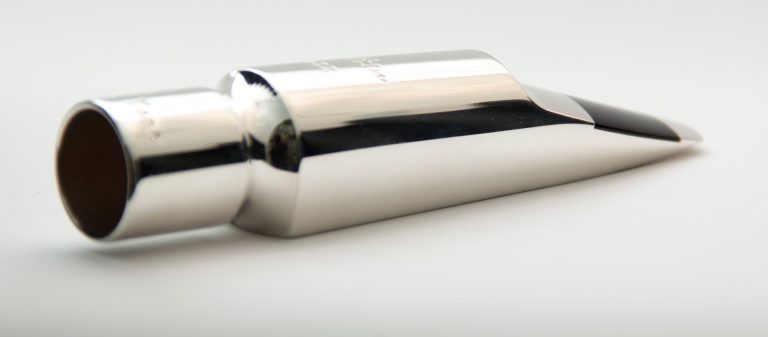
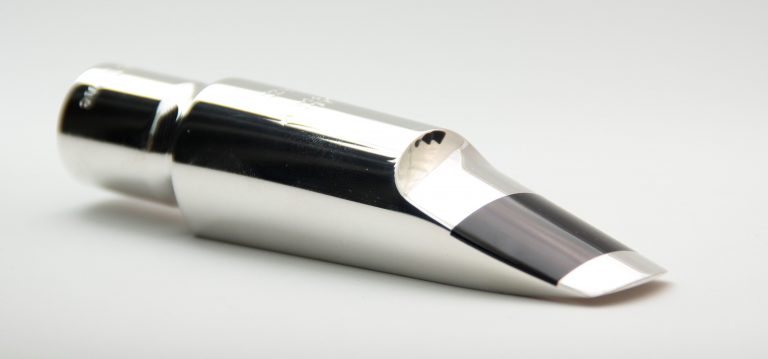
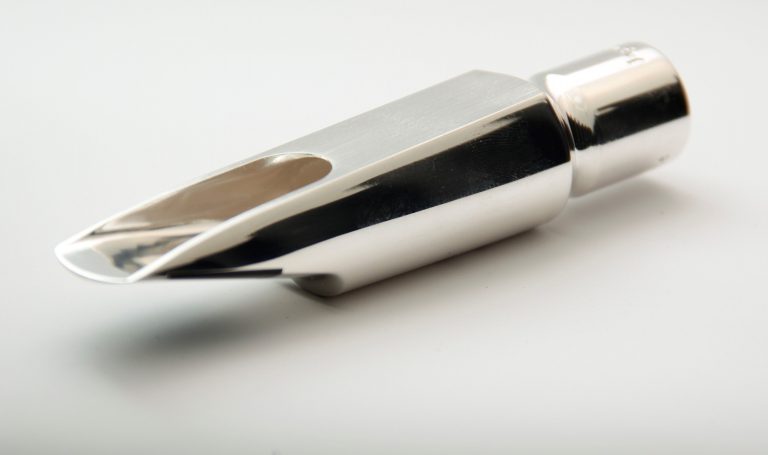
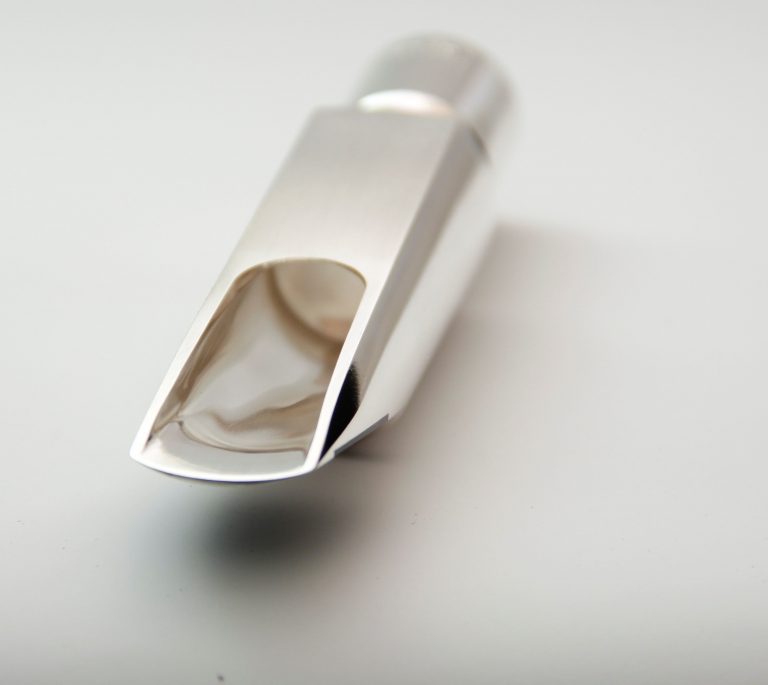
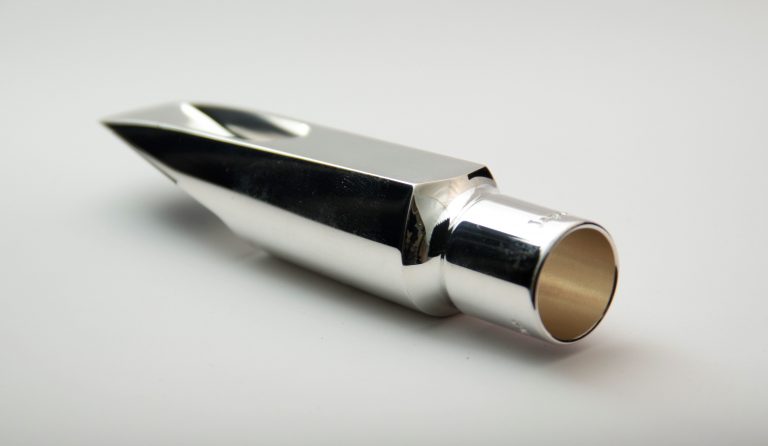



Gottsu Master 2018
The Master 2018 is what the Gottsu company calls its „flagship model“. It is difficult to follow this designation in view of the high standard that the manufacturer already achieves with its Sepia Tone Jazz Metal, which it itself classifies as a „Standard Metal Model“. What does the Master 2018 do better than a Sepia Tone Jazz metal? The surface treatment of the Master 2018 is more elaborate and of higher quality: after extremely precise production and careful finishing, the mouthpiece is first nickel-plated and then an 18k gold plating is applied. The Gottsu company explains that during the development of this mouthpiece, the metal alloy of the historical original was analysed and a brass alloy was chosen which most closely resembles the original. The Master 2018 is currently produced exclusively for the tenor saxophone.
The design of the Master 2018 is clearly based on a classic, namely the Otto Link Master, which appeared on the market in 1930. The Otto Link Master is closely associated with two of the most important tenor saxophonists in jazz: Coleman Hawkins and Ben Webster blew this mouthpiece. The original Otto Link Master was delivered with only small tip-openings. Ben Webster and others had their Master opened afterwards, partly by a service of the Otto Link company. The Gottsu company offers different tip-openings, including wide ones, from the factory. The present mouthpiece for tenor saxophone has a tip-opening of 8, which corresponds approximately to the tip-opening of 7* of a current Otto Link metal mouthpiece.
The appearance of the Master 2018 is closely based on that of the historic Otto Link Master: there is this characteristic short shaft with a strong throat at the transition to the body of the mouthpiece. At the base of the shaft there are two parallel shaft rings with „Sepia Tone“ engraved between them. Below the table, i.e. the bearing surface for the reed, there are narrow ridges on both sides of the mouthpiece into which a reed screw could be inserted in the historical original mouthpiece. However, the Master 2018 only quotes this design without offering the same function.
The design of the chamber and baffle largely follows the design of the historical model: the tip-rail of the Master 2018 is significantly narrower than that of the Sepia Tone Jazz metal. There is a very tight rollover baffle, which merges smoothly into a low baffle. This baffle, which is slightly flatter in cross-section than that of the Sepia Tone Jazz metal, descends very steeply into the large, round chamber. As with the Sepia Tone Jazz metal, the side walls are deeply and roundly hollowed out, the transitions to the baffle take place in soft, smoothly polished curves. Everything that has been written here before regarding the product quality of the Sepia Tone Jazz metal is even more true for the Master 2018: this mouthpiece is absolutely precise and perfectly produced, balanced and it is a real beauty! While the Sepia Tone Jazz metal is rather defined as an all-round mouthpiece, which has a clear signature in terms of sound but can be moved in different sonic directions by the experienced player, the Master 2018 has something that can only be described as such: character!
The sound of the Master 2018 has a very large, warm, colourful and dark tone, which is wonderfully broad. There are mouthpieces that sound dark, but at the same time also dull or muffled. However, the Master 2018 always gives the sound sufficient brilliance and presence. A certain brilliance and sufficient assertiveness can be developed effortlessly. With this sound concept it is similar to Theo Wanne Ambika III, which however sounds much more modern, contoured and also harder. The Master 2018 sounds softer, has something sweet in its tone, also a certain density. The dynamic range of the Master 2018 does not differ from that of Sepia Tone Jazz metal and is therefore very high: no matter whether you blow fortissimo or pianissimo, move in the range of the subtones or the flageolets, the basic substance of the tone always remains completely stable and dense. Subtones, especially in the lower registers, can be controlled with ease. The intonation is very good. The Master 2018 is an excellent mouthpiece, a modern, contemporary interpretation of an Otto Link Master, sounding a little more present than this one, but this is by no means to its disadvantage. Masahiko Goto’s claim and promise to produce a mouthpiece whose sound approaches that of the human voice when played appropriately, is fulfilled in a successful way with the Master 2018!


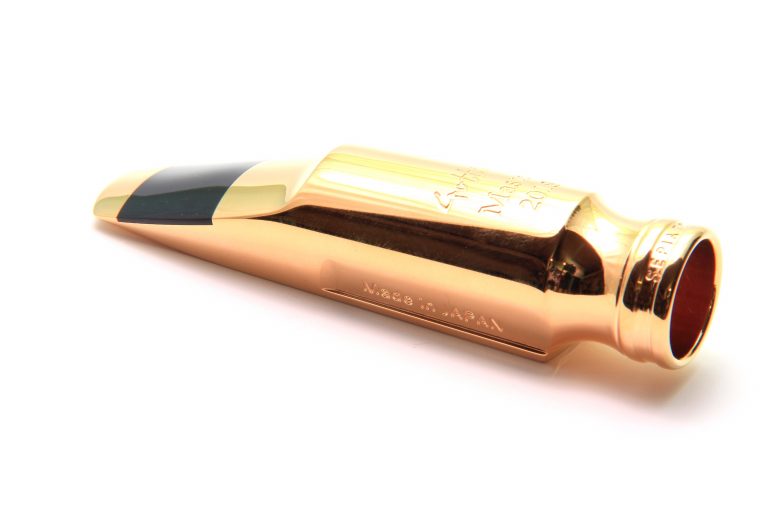


Gottsu Sepia Tone Double Ring Tenor
The Sepia Tone Double Ring Tenor is on the market since 2020. Its concept refers to the design of the Otto Link Double Ring, a metal mouthpiece which the American manufacturer introduced in 1950. A number of the most important saxophonists of jazz blew this model. Well preserved copies or even those in original condition are very rare and accordingly expensive. A certain serial dispersion in production has a tradition at the Otto Link company. Therefore, it is not without problems to speak of the characteristic sound of the Double Ring or Florida: the product quality and design of the mouthpieces in question were already subject to considerable fluctuations at that time, so that the still existing copies, once regardless of their state of preservation, often differ greatly in sound and also in their respective playing characteristics. This, by the way, applies to the current products of the Otto Link company: one is well advised to choose the best one from several copies of the same model! Nevertheless, many people consider the so-called Double Ring to be the best sounding metal mouthpiece produced by Otto Link and, only produced in manageable quantities, also the most sought-after. Many musicians who blew a double ring, however, subjected their mouthpiece to an elaborate refacing in order to optimise the playing characteristics of their instrument and mouthpiece. Manufacturers such as Theo Wanne, for example, restored mouthpieces, developed methods of refacing before later starting to develop their own mouthpieces. Masahiko Goto, too, gained several years of experience in refacing and only later decided to produce his own mouthpieces. This knowledge about the optimal facing curve, also the exact knowledge of historical models, is of benefit for the development of a modern mouthpiece such as the Gottsu Sepia Tone Double Ring.
Some manufacturers have been offering replicas of this mouthpiece for quite some time now: among others the companies Retro Revival, Marantz, Ted Klum, Sakshama, Phil Tone, but also Rafael Navarro or Theo Wanne refer to the Otto Link Double Ring. However, none of these manufacturers is able to produce an exact and to a certain extent universally valid replica of the Otto Link Double Ring, even with the most modern laser scanning methods, because the original, as already mentioned, was subject to certain variations in design and quality. Retro Revival, for example, would like to point out that they used the best preserved and playable copy that was still available to them and used this as a reference model and template for their replica. In this respect there are, if at all, only replicas of a very specific individual copy. Other manufacturers, such as Theo Wanne, claim that they produce the model that surpasses the best examples of the surviving historical models. Be that as it may, the term homage is probably most applicable to the characteristic of the respective product, and what is so bad about enjoying a successful homage instead of a replica? In the end, all that matters is how you sound on a mouthpiece and not what it is called and what price you pay for it. There are only good or bad mouthpieces.
In this sense, i.e. as a homage, the Gottsu company apparently designed its Sepia Tone Double Ring.
Everything that has been written here before regarding the product quality of the Sepia Tone Jazz Metal and Master 2018 applies to the Master 2018: this mouthpiece, declared as handmade, is absolutely precise and perfectly produced, balanced and it is a jewel!
The external appearance of the Sepia Tone Double Ring is very similar to that of the historical Otto Link Master: there is this characteristic short shaft with a pronounced throat at the transition to the body of the mouthpiece. At the base of the throat there are two rings engraved in parallel: hence the name Double Ring. On the top of the mouthpiece there is a flat metal band that rises longitudinally and bears the engraved inscription Gottsu. The design of the chamber and baffle essentially follows the design of the historical model. The tip-rail of the Master 2018 is considerably narrower than that of the Sepia Tone Jazz metal, exceptionally fine and precisely worked out. There is a rollover baffle of medium to low height, which merges smoothly into a low baffle about 5 mm behind the tip-rail and descends deeply into a large and smoothly rounded chamber. This surface of the baffle is slightly flatter in cross-section than that of the Sepia Tone Jazz metal. As with the Sepia Tone Jazz metal and Master 2018, the side panels are deeply and roundly hollowed out, the transitions to the baffle are in soft, smoothly polished curves. Every detail is precisely and perfectly executed.
While the Sepia Tone Jazz metal is defined more as an all-round mouthpiece that has a clear signature sound but can be shifted in different sonic directions by the experienced player, the Master 2018 and now also the Sepia Tone Double Ring have something that can only be described as: plenty of character! The blowing resistance is low, but is designed to provide optimum sound control. The mouthpiece blows much more freely and openly than the Sepia Tone Jazz metal, but gives a touch more resistance than a Retro Revival Super D or Theo Wanne Gaja III. For all mouthpieces of the company Gottsu and especially for the Sepia Tone Double Ring the following applies: the blowing resistance is exactly right! Although the mouthpiece responds exceptionally easily, it provides the wind player’s embouchure with exactly the support he needs for a controlled and well-balanced tone.
Like the Sepia Tone Jazz metal and the Master 2018, the Sepia Tone Jazz metal is extremely tolerant of reeds of different thickness and different cuts: a Vandoren Classique No. 3 sounds just as good on this mouthpiece as a Vandoren Java No. 3.5 or Vandoren V16. A Casual Signature synthetic reed also works with the Sepia Tone Double Ring. As a ligature, the Wood Stone Tenor Otto Link M GP Ligature is especially recommended for this mouthpiece. But also with the Platinum Ligature from Rovner the best results can be achieved.
The Sepia Tone Double Ring really opens up all possibilities: depending on how you play it, it can sound soft and dark, almost sweetish or sharply focussing. The spatial depth of the tone is striking: some other mouthpieces may sound loud and wide, large and round, but the sound lacks something you could call its spatiality, it seems flat. With a Sepia Tone Double Ring the tone stands in the room like a marble statue. There is a clearly defined, dark and warm core and around it several layers of rich overtones. The tone is very assertive, contoured. The dynamic range of the Sepia Tone Jazz metal is extremely wide: whether you blow pianissimo or fortissimo, the basic substance of the tone always remains stable, clearly outlined. Subtones, the lower registers as well as the highest are easily controllable, as are the harmonics. The intonation is very good. The Sepia Tone Double Ring is an excellent mouthpiece, which makes it possible to express the most different facets of the sound, the own playing perception. This mouthpiece grows with its player and the player with it. Whether it is a successful replica or a homage, it is one of the most outstanding mouthpieces of its kind currently available.
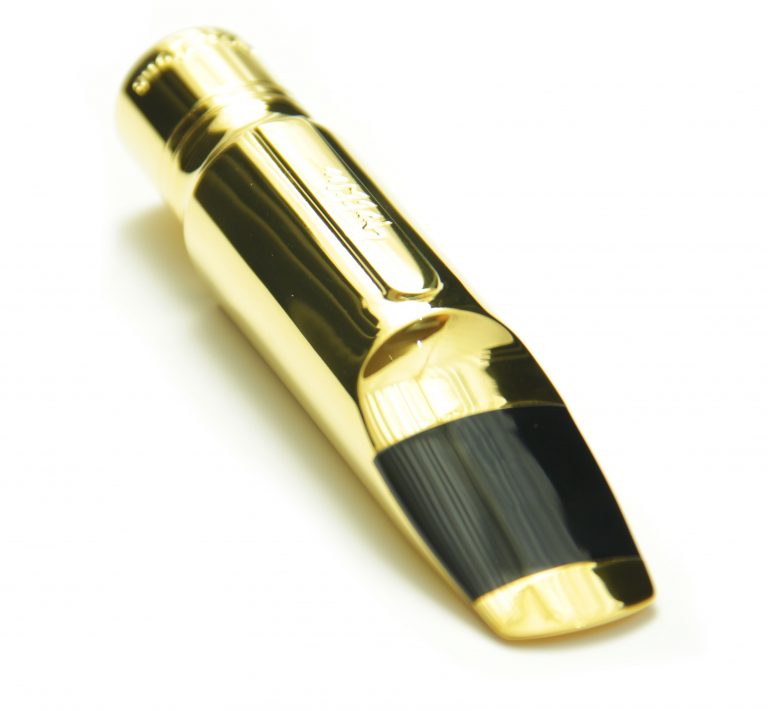
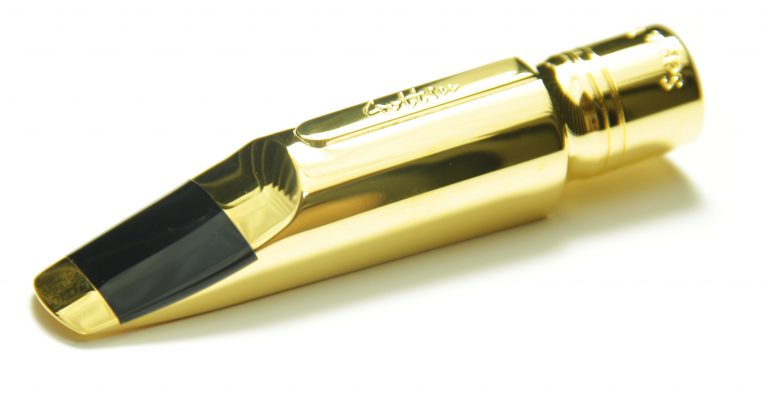
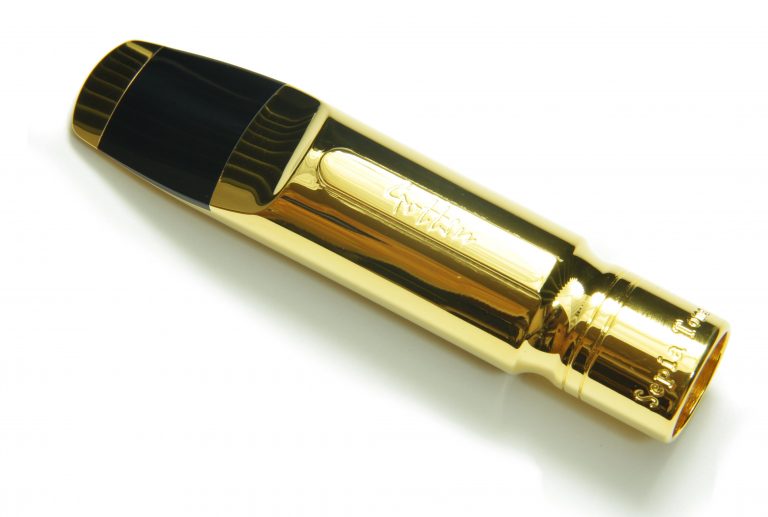


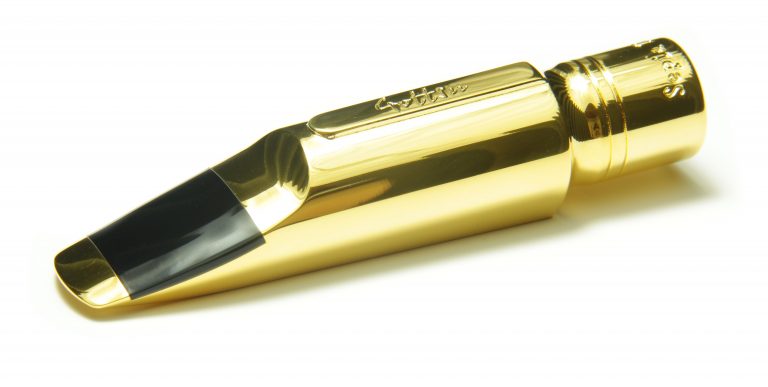
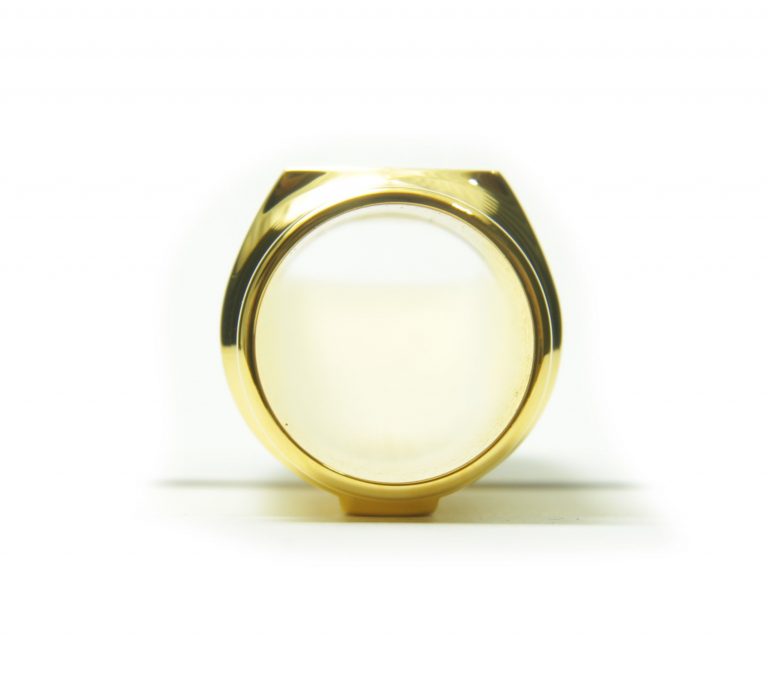

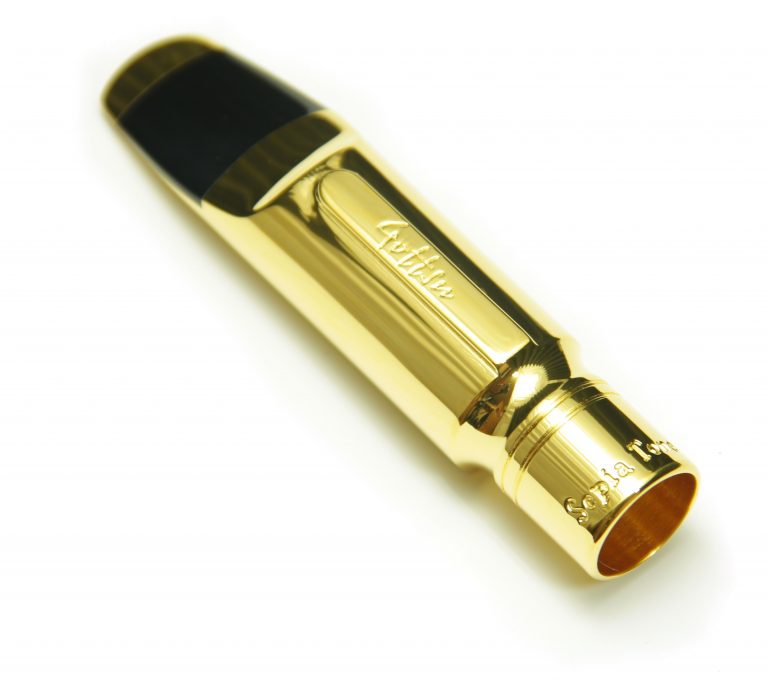
Gottsu Jazz Solist
The Gottsu Jazz Soloist is a hard-rubber mouthpiece which refers to the design of the Selmer Short Shank Soloist from 1956. This mouthpiece, originally conceived for use in classical music, has also found favour with some of the most important saxophonists in jazz. Joe Henderson blew a Short Shank D on his Selmer MK VI tenor saxophone, Kenny Garrett still uses a Short Shank F on his Selmer MK VI alto saxophone. This mouthpiece is actually unjustly and incomprehensibly overshadowed by the mouthpieces sold by the American companies Meyer or Otto Link. It is a mouthpiece that finds its tonal home in completely different genres. The soloist can be used in classical music as well as in jazz without restrictions. It is therefore a real all-round mouthpiece. A good short shank is characterised by a very fast and precise articulation, a particularly colourful sound, which always seems a bit compressed and slender, but not thin or flat, a sound which is focused and also radiant, but never shrill or harsh in the trebles.
The Gottsu Jazz Soloist is available for soprano, alto, tenor and baritone saxophone.
The Selmer company has been restoring the Soloist for a number of years, but you are well advised to choose the best one from several copies of the same web opening. There are other manufacturers who also offer mouthpieces that are close to the conception of the historic Selmer Short Shank. Here, representative for some others, are mentioned: The Japanese company Aizen produces the Aizen SO. This mouthpiece sounds much brighter and sharper than the historical original, the blowing resistance is infinitesimally low, the intonation behaviour is not optimal in my experience. The American company Retro Revival produces the so-called Shorty. This mouthpiece has the sound characteristics of a good short shank, blows freely and lies a little more on the pithy side of the sound spectrum. Edward Pillinger, London, calls his homage to the Short Shank simply Pillinger SO. This excellent mouthpiece, blows very freely, develops an enormous projection and also brilliance. It sounds round, intonation is perfect. With its model called Nouvella, the Phil Tone company offers an extremely successful and appealing homage to the Selmer Short Shank: the Nouvella is not only produced with outstanding precision, but also comes very close to the sound characteristics in an amazing way. However, and this unites the current efforts of all manufacturers, Phil Tone attaches great importance to somewhat more balanced playing characteristics. Many copies of the historical original have a too high blowing resistance in certain positions, a reduced dynamic range or even a loss of brilliance. The Nouvella combines the sound signature of a short shank with a comfortably easy playability.
The Jazz Soloist is available with a tip-opening of G for tenor saxophone and a tip-opening of D for alto saxophone. G is roughly the same as the tip-opening of 7 of an Otto Link, D is the same as a tip-opening 5 of a USA Meyer mouthpiece. Both mouthpieces are produced absolutely precise and accurate, the finish is flawless. The outer surfaces of the mouthpieces are finely matted.
The appearance of the Gottsu Jazz Soloist closely follows the design of the historic Short Shank. There is this characteristic short shaft that gave the Short Shank its name. A strong cove is located in the transition between the shaft and the body of the mouthpiece. Immediately in front of this cove there is a shaft ring in the form of a flat band, which in the original has a border, in the modern version Gottsu’s writing Sepia Tone. The shaft is rounded towards its end. On the table of the Jazz Soloist the inscription „S.Shank“ as well as the track name can be read in deep engraving. The original Short Shank showed on the table the model name and track opening.
The Short Shank has a horseshoe-shaped chamber cut-out and a very flat baffle at the transition to the bore of the mouthpiece shaft. The Gottsu Jazz Soloist follows this design concept of the original Short Shank. Tip-Rail and Side-Rails are extremely precise, very fine and narrow. There is a discreet rollover baffle at the transition from the mouthpiece tip to the baffle, hardly visible and only to be felt. The chamber seems to be slightly larger than that of the Short Shank from 1956. Everything that has already been noted here regarding the product quality of the Sepia Tone Jazz Metal, the Master 2018 and the Sepia Tone Double Ring is also true for the Jazz Soloist: this mouthpiece is absolutely precise and perfectly produced, balanced, the finish pleases the eye!
The sound of the jazz soloist knows how to inspire. Tony Lakatos, one of the most internationally renowned soloists, commented on this mouthpiece: “I fell in Love with that Piece! You automatically hear Joe Henderson in your ears when you play it. Soloist chamber, but I can blow more air inside than in the original and get more volume which was always missing in those mouthpieces.”
In fact, the blowing resistance of this Gottsu Jazz Soloist is much lower than that of the Selmer Soloist from both current production and the majority of historical series. It is a little bit higher than the comparable models of Phil Tone, Pillinger and Aizen. Nevertheless: this mouthpiece blows very easily! The blowing resistance, only increased by a fine nuance compared to the models of comparable competitors on the market, is only to the advantage of the tone control. It is striking that the special colour and warmth of the sound, this certain enamel or ear-flattering softness, which can be achieved with a good original short shank from 1956, can be heard in a completely equal way with the Gottsu Jazz Soloist, made in 2020. Used on a Yamaha 82Z WOF UL tenor saxophone, a Yamaha 875 EX and 82 Z WOF UL alto saxophone as well as a Buffet Crampon S1 and Senzo, the especially balanced intonation over the whole range of the instruments was remarkable.
The mouthpieces work particularly well with the Platium Ligature from the American company Rovner, the Ligature from the Japanese company Wood Stone and the ligatures from the Belgian manufacturer Francois Louis. The Gottsu Jazz Soloist accepts reeds of different sizes and thickness. Even synthetic reeds like the Signature of the Legere company sounded excellent with this mouthpiece, even though the Gottsu company strongly recommends the use of wooden reeds.
The Gottsu Jazz Soloist, just like the other mouthpieces of this manufacturer, allows for playing with the greatest dynamic contrasts. The tone always remains controllable and stable, no matter what position or volume you move in. One might associate the Short Shank with a fine, slender, cultivated, warm and colourful sound, and this idea is perfectly true. However, it is quite possible to elicit a tone of concise, focused sharpness from the Gottsu Jazz Soloist, if you give it enough air and support. The Gottsu Jazz Soloist is an outstanding all-round mouthpiece, which allows the player to do a lot of things and is an extremely successful homage to the original Short Shank. The Gottsu Jazz Soloist not only corresponds to its historical model as far as possible in terms of sound, but also surpasses it in terms of playability and excellent and comfortable tone control.

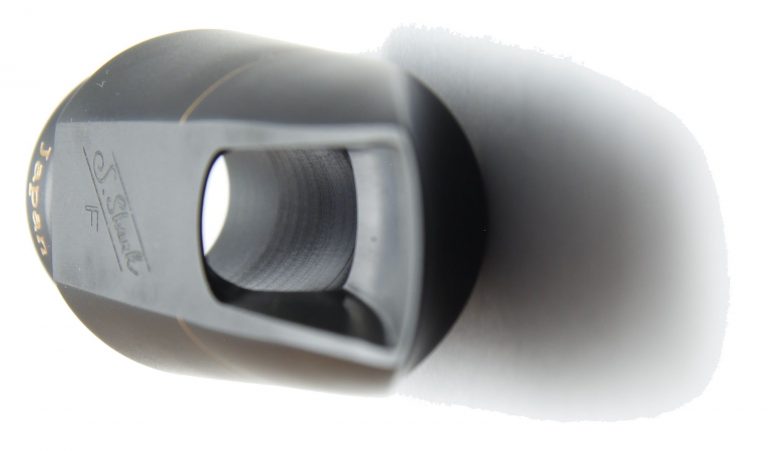

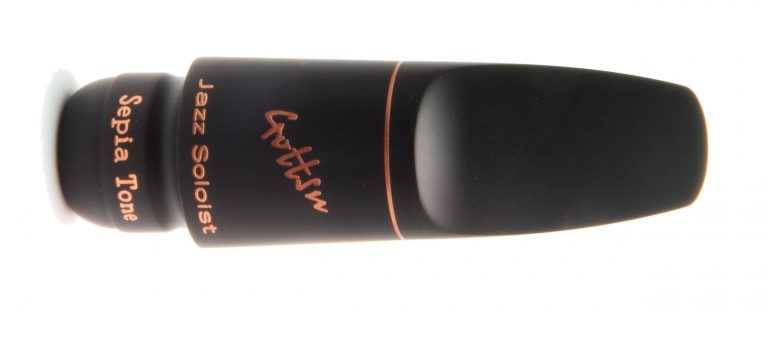

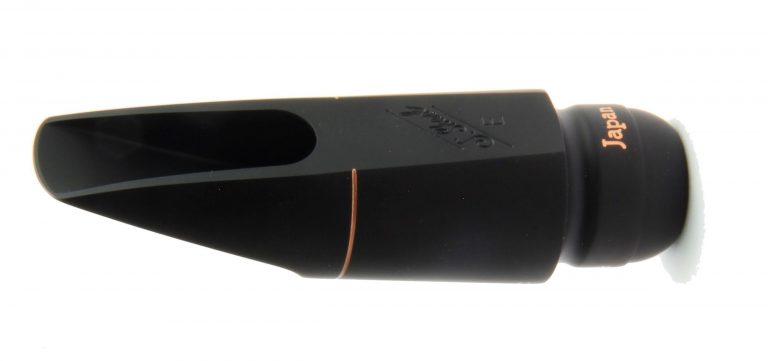
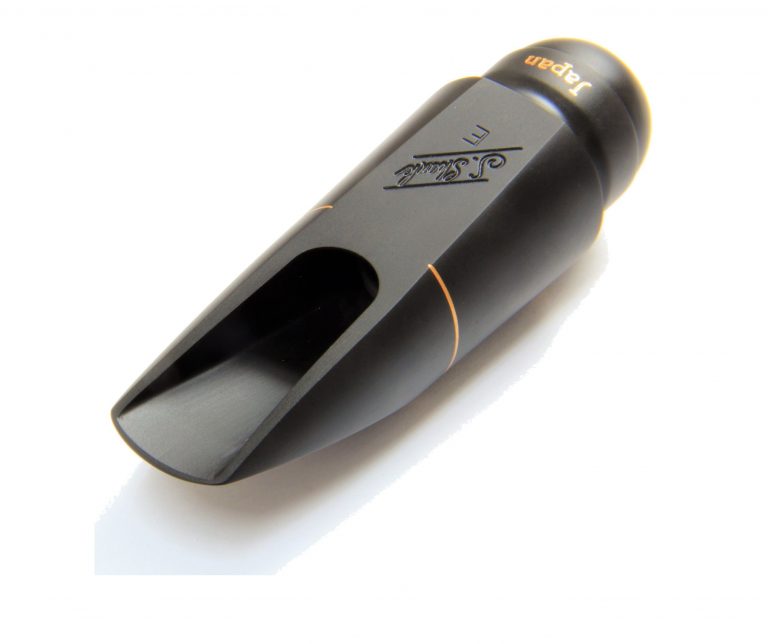
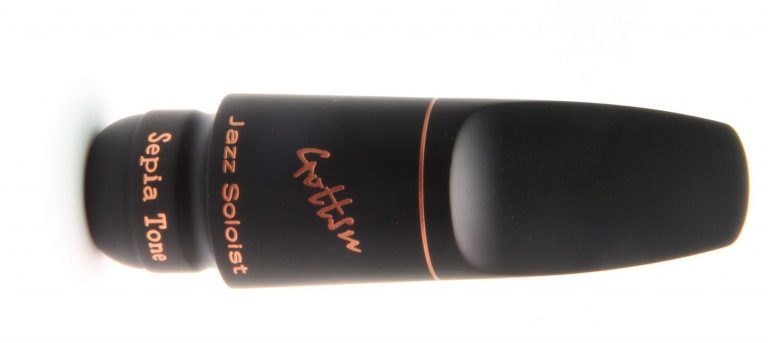
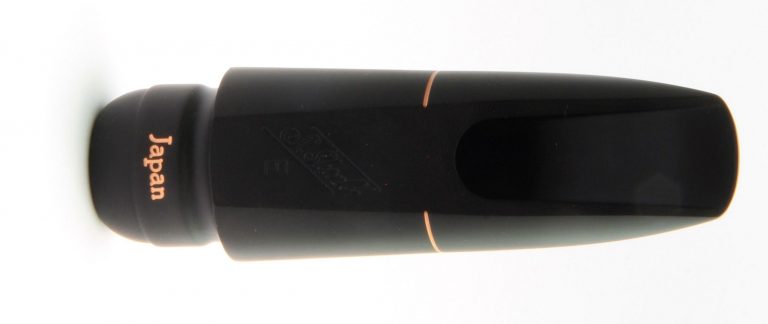
Summary
The mouthpieces presented and discussed here represent only a selection: the range of the company Gottsu is meanwhile extensive and basically provides something suitable for every demand and taste. All mouthpieces of this manufacturer, who in the course of the last 15 years has steadily expanded and carefully developed his product range, have this in common: the mouthpieces are excellently produced by hand and follow a product philosophy which is primarily concerned with the possibilities of musical expression and less with what is technically feasible. These mouthpieces are made for musicians and not for instrumentalists. This special characteristic and quality is what makes them stand out. With his works – the Sepia Tone Jazz Metal, the Master 2018, the Sepia Tone Double Ring and Jazz Soloist – Masahiko Goto and his company Gottsu deservedly and justifiably rank among the most outstanding international mouthpiece producers.